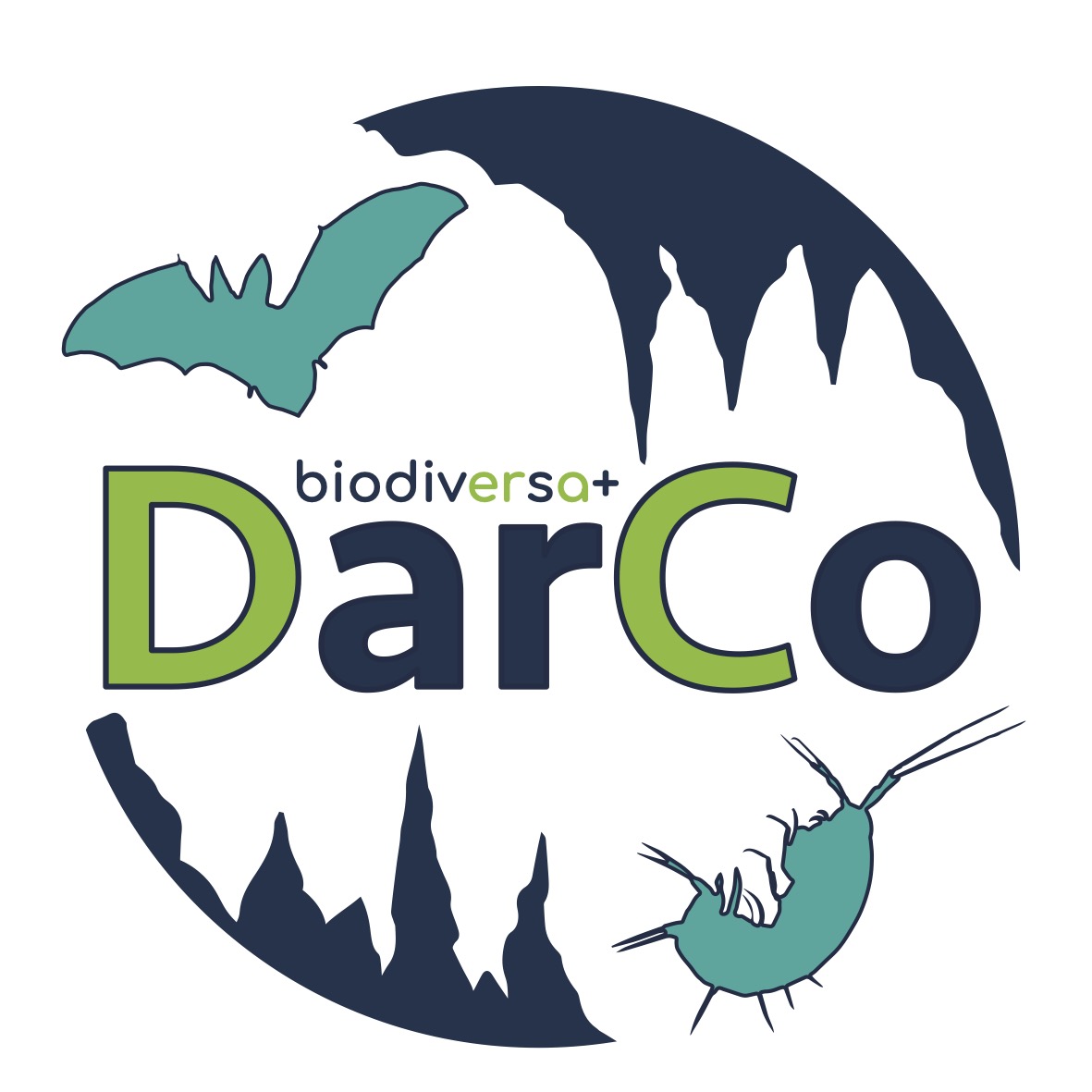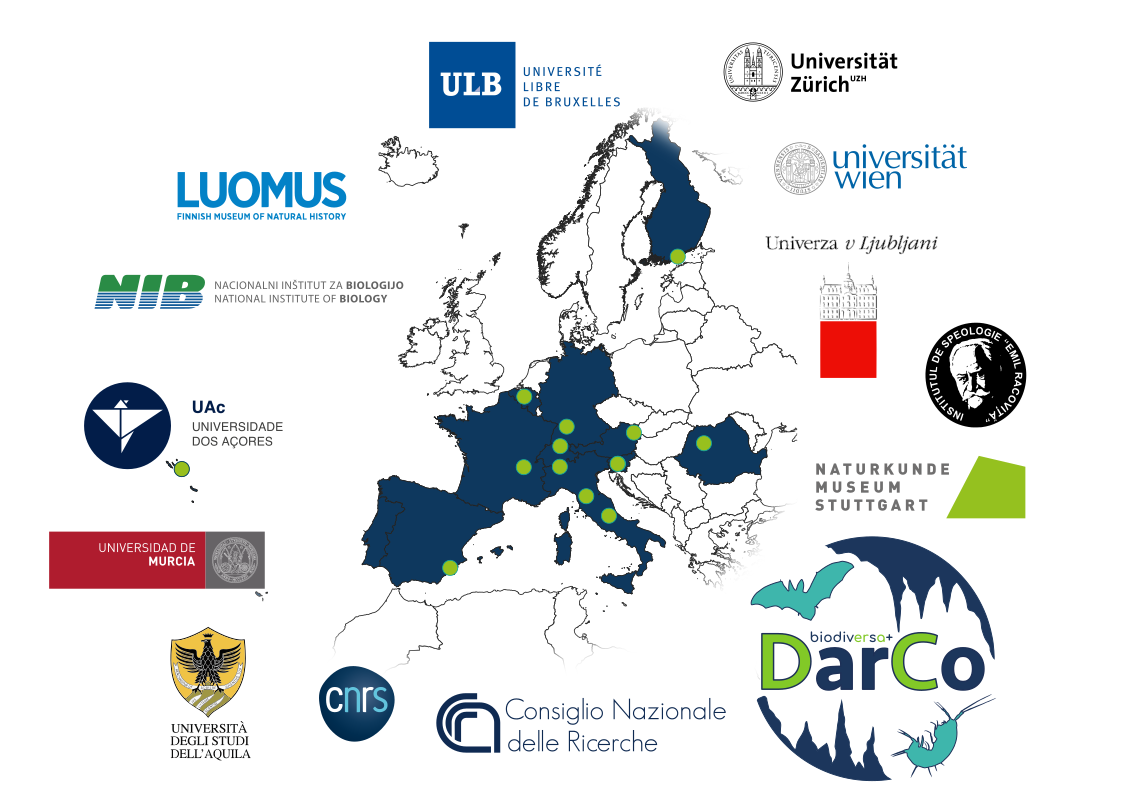DarCo Project
The vertical dimension of conservation:
A cost-effective plan to incorporate subterranean ecosystems in post-2020 biodiversity and climate change agendas

Biodiversa+ 2021–2022 joint call
“Supporting the protection of biodiversity and ecosystems”

Project duration: 2023–2026
Total Budget: 1.652.031€

Summary: Subterranean ecosystems host a broad diversity of specialized and endemic organisms that account for a unique fraction of the global taxonomic, phylogenetic, and functional diversity. Furthermore, they deliver crucial ecosystem services—especially the provisioning of potable water to more than half of the world’s population. Yet, these out-of-sight ecosystems are systematically overlooked in post-2020 biodiversity and climate change targets. Only 6.9% of known subterranean ecosystems overlap with the global network of protected areas, with just a few of these areas designed to account for their vertical dimension. Two main impediments are responsible for this lack of protection. First, subterranean biodiversity patterns remain largely unmapped, even in areas with a long speleological tradition such as Europe. Second, we lack a mechanistic understanding of subterranean species' response to human-induced perturbations. The project DarCo aims to map subterranean biodiversity patterns across Europe and develop an explicit plan to incorporate subterranean ecosystems in the European Union (EU) Biodiversity Strategy for 2030. To this end, we have established a multidisciplinary team of leading scientists in subterranean biology, macroecology, and conservation science from a broad range of European countries. The project is articulated in three interconnected work packages devoted to direct research (WP2–4), plus a fourth package (WP5) aimed at maximizing the dissemination of results and engagement of stakeholders to implement practical conservation. First, by compiling existing databases and leveraging a capillary network of international collaborators, we will gather distribution data, traits, and phylogenies for all major subterranean animal groups, including crustaceans, mollusks, insects, and vertebrates (WP2). These data will serve to predict species responses to human threats using Hierarchical Modelling of Species Communities (WP3). Models' predictions of biodiversity change will provide the basis for a dynamic mapping of European subterranean life. By intersecting maps of diversity patterns, threats, and protected areas, we will design a plan to protect subterranean biodiversity complementing the current EU network of protected areas (Natura 2000), while taking into account climate-driven shifts in subterranean ecoregions (WP4). Finally, through target activities in WP5, we seek to raise societal awareness about subterranean ecosystems and invite stakeholders to incorporate subterranean biodiversity in multilateral agreements. In compliance with the European Plan S, we will make all data open and re-usable by the development of a centralized and open database on subterranean life—the Subterranean Biodiversity Platform. This will ensure that future generations will be able to build upon knowledge accumulated on subterranean biodiversity and monitor the effectiveness of today’s protection measures in the years ahead.

The target system: The project focuses on terrestrial and aquatic subterranean ecosystems across Europe, including caves (karst and volcanic), fissural systems, anchialine systems, aquifers, and subterranean artificial habitats (e.g., mines). Their specialized and often endemic fauna is not homogeneously distributed throughout the continent and does not necessarily follow politically defined country borders. Known hotspots of subterranean biodiversity mostly concentrate in southern Europe, especially across the main mountain ranges (the Pyrenees, Alps, Apennines, and Dinarides), as well as in lava-tubes, volcanic pits, and fissural systems in volcanic oceanic islands (the Azores, Canary Islands). Most subterranean diversity hotspot areas in continental Europe occur in what has been defined as a “ridge of high subterranean biodiversity”, roughly between 42–46° latitude, where there is a high density of subterranean habitats and high surface productivity. Conversely, subterranean biodiversity is significantly reduced at northern latitudes, because the fauna therein was likely extirpated during Quaternary glaciation cycles. Based on this background knowledge, we will include all available data across Europe, with a deeper focus on circum-Mediterranean countries and main oceanic islands but also considering the scant data on subterranean communities at northern latitude.

[Credit: uPIX fotografia ipogea]
Expected impacts: DarCo will generate openly accessible, data-driven scientific evidence supporting the inclusion of subterranean systems in European conservation plans and biodiversity goals (Habitats Directive, Water Framework Directive, Groundwater Daughter Directive, EU Biodiversity Strategy for 2030). Given that subterranean ecosystems are largely overlooked in global biodiversity goals and climate change agendas, this will be per se a crucial and novel achievement. DarCo will offer novel viewpoints on how to approach the protection of subterranean biological communities in a practical and cost-effective way. Currently, most research in subterranean biology focuses on taxonomy and faunistic (e.g., checklist of species, description of new taxa), local ecology (e.g., study of individual cave’ communities), and evolution (e.g., studies on subterranean adaptation and speciation). Conversely, studies about conservation of the biological components of subterranean ecosystems have significantly lagged behind compared to above-ground ecosystems. Furthermore, the sensitivity of subterranean species to climatic alterations and habitat change remains largely unknown. For example, the few studies forecasting the responses of subterranean organisms to climate change were correlative and focused on single-model taxa, thus lacking the explanatory power to provide a mechanistic description of the processes involved. This project, by integrating abiotic and biotic data into innovative models at broad spatial scales, will represent an important leap forward in this area, producing relevant conservation information not available hitherto. DarCo will also produce useful knowledge expanding our current understanding of the ecology of subterranean ecosystems. Despite the fact that caves are often regarded as ideal “natural laboratories” for eco-evolutionary studies, there are only a few concrete examples of studies that have successfully exported their results outside the narrow borders of the scientific discipline of subterranean biology. Subterranean ecosystems are simplified settings for the study of ecological processes, given their island-like nature, reduced climatic variability, and limited number of species and interactions compared to surface ecosystems. The outputs of WP3 will thus help to understand the mechanisms behind species responses to environmental changes, providing an operational roadmap guiding future studies in other settings.

DarCo's team
We have established a research consortium composed of international researchers in subterranean biology and conservation science. The consortium involves 11 countries and 13 research institutes, totaling >50 team members. Accordingly, we will be able to cover the breadth of subterranean habitats and taxa across Europe within a unified framework and shared databases. Our consortium includes leading scientists on subterranean biology operating across main subterranean areas in the continent and oceanic islands, curators of main databases on subterranean species distributions and traits, and researchers holding expertise in taxonomy, ecological modeling, phylogenetic methods, functional diversity, and spatial prioritization.

Partner 01: National ResearchCouncil, Water Research Institute (IRSA-CNR) Project Coordinator: Stefano Mammola
Partner 02: University of Murcia, Department of Ecology and Hydrology (UMU) Principal investigator: David Sánchez-Fernández
Partner 03: Universidade dos Açores, Faculdade de Ciências Agrárias e do Ambiente (UAC) Principal investigator: Paulo P.A.V. Borges
Partner 04: University of Helsinki, Finnish Museum of Natural History (LUOMUS) Principal investigator: Thomas Lilley
Partner 05: Université Libre de Bruxelles, Departement de Biologie des Organismes (ULB) Principal investigator: Jean-Francois Flot
Partner 06: Centre National de la Recherche Scientifique, Université Claude Bernard Lyon 1 (CNRS) Principal investigator: Florian Malard
Partner 07: Stuttgart State Museum of Natural History (SMNS) Principal investigator: Arnaud Faille
Partner 08: University of Zurich, Department of Evolutionary Biology and Environmental Studies (UZH) Principal investigator: Florian Altermatt
Partner 09: University of Vienna, Department of Functional and Evolutionary Ecology (UNIVIE) Principal investigator: Christian Griebler
Partner 10: University of L'Aquila, Department of Life, Health and Environmental Sciences (UnivAQ) Principal investigator: Diana M.P. Galassi
Partner 11: University of Ljubljana, Biotechnical Faculty, Department of Biology (UL) Principal investigator: Maja Zagmajster
Partner 12: National Institute of Biology, Department of Organisms and Ecosystem Research (NIB) Principal investigator: Nataša Mori
Partner 13: Romanian Academy / Emil Racovita Institute of Speleology (ISER) Principal investigator: Traian Brad
Publications
[DarCo's team members are highlighted in bold]
Baba ŞC, Giurginca A, Popovici G, Sarbu SM, Popa OP (2024). A new cave-dwelling species of the genus Geophilus Leach, 1814 (Chilopoda: geophilomorpha) from the chemoautotrophic-based Movile Cave (Southern Dobrogea, Romania). The European Zoological Journal, 91(2), 855–868. [Partner 13]
Bertrand M, Manu M, Sarbu SM, Stefan A (2024). Labidostomma motasi rediscovered: a witness of the Messinian crisis? (Acari: Labidostommatidae). Annales de La Société Entomologique de France (N.S.), 1–13. [Partner 13]
Cedrés-Perdomo RD, Polaíno-Martín C, Jennings L, Gabriel R (2024). Seeking a Hideout: Caves as Refuges for Various Functional Groups of Bryophytes from Terceira Island (Azores, Portugal). Diversity 16, 58. [Partner 3]
Cerasoli F, Fiasca B, Di Lorenzo T, Lombardi A, Tomassetti B, Lorenzi V, Vaccarelli I, Di Cicco M, Petitta M, Galassi DM (2023). Assessing spatial and temporal changes in diversity of copepod crustaceans: a key step for biodiversity conservation in groundwater-fed springs. Frontiers in Environmental Science, 11: 659. [Partners 1, 10]
Colado R, Abellán P, Pallarés S, Mammola S, Milione R, Faille A, Fresneda J, Sanchez-Fernández DS (2023). A dark side of conservation biology: protected areas fail in representing subterranean biodiversity. Insect Conservation and Diversity, doi: 10.1111/icad.12666. [Partners 1, 2, 7]
Delić T, Pipan T, Ozimec R, Culver DC, Zagmajster M (2023). The subterranean species of the Vjetrenica cave system in Bosnia and Herzegovina. Diversity 15: 912. [Partner 11]
Delić T, Lohaj R, Brestovanský J, Čáha D, Jalžić B (2023). Questioning the monophyly of Anthroherponina (Coleoptera: Leiodidae: Cholevinae: Leptodirini) and description of three new, ecologically ultraspecialized subterranean species. Zoological Journal of the Linnean Society, zlad090. [Partner 11]
Di Cicco M, Di Lorenzo T, Fiasca B, Galmarini E, Vaccarelli I, Cerasoli F, Di Camillo AT, Galassi DM (2023). Some like it hot: Thermal preference of the groundwater amphipod Niphargus longicaudatus (Costa, 1851) and climate change implications. Journal of Thermal Biology, 103654. [Partners 1, 10]
Di Cicco M, Tabilio Di Camillo A, Di Marzio W, Sáenz ME, Galassi DM, Pieraccini G, Galante A, Di Censo D, Di Lorenzo T (2024). Subchronic Effects of Tetrachloroethylene on Two Freshwater Copepod Species: Implications for Groundwater Risk Assessment. Environmental Toxicology and Chemistry, doi: 10.1002/etc.5977. [Partners 1, 10]
Di Lorenzo T, Galassi DMP, Di Camillo AT, Pop MM, Iepure S, Piccini L (2023). Life-History Traits and Acclimation Ability of a Copepod Species from the Dripping Waters of the Corchia Cave (Apuan Alps, Tuscany, Italy). Water, 15(7): 1356. [Partners 1, 10]
Di Lorenzo T, Mori N, Simčič T (2024). Metabolic rates of groundwater species as a function of body mass and temperature. Subterranean Biology, 49: 53-74. [Partners 1, 12]
Duarte C, Lorenzo T, Reboleira ASPS (2024). Environmental risk of diclofenac sodium in European groundwaters: implications for setting environmental quality standards. Scientific Reports, 14: 20689. [Partners 1, 3]
Gavish‐Regev E, Frumkin A, Na'aman I, Langford B, Aharon S, Ya'aran S, Kolodny O, Mammola S (2023). The power of academic and public opinion in conservation: The case of Ayyalon Cave, Israel. Integrative Conservation 2: 73–79. [Partner 1] [Journal Cover]
Knüsel M, Borko Š, Alther R, Salussolia A, Flot J-F, Altermatt F, Fišer C, Stoch F (2023). Phylogenetic structure and molecular species delimitation hint a complex evolutionary history in an Alpine endemic Niphargus clade (Crustacea, Amphipoda). Zoologischer Anzeiger - A Journal of Comparative Zoology 306: 27–36. [Partners 5, 8, 11]
Malek-Hosseini MJ, Brad T, Fatemi Y, Kuntner M, Fišer C (2023). A new cave-dwelling hadzioid amphipod (Senticaudata, Hadzioidea, Melitidae) from sulfidic groundwaters in Iran. Contributions to Zoology, 1–20. [Partners 11, 13]
Mammola S (2024). Conservation of subterranean insects. Routledge Handbook of Insect Conservation, Chapter: 24. [Partner 1]
Mammola S, Altermatt F, Alther R, Amorim IR, Băncilă RI, Borges PA V, Brad T, Brankovits D, Cardoso P, Cerasoli F, Chauveau CA, Delić T, Di Lorenzo T, Faille A, Fišer C, Flot J-F, Gabriel R, Galassi DMP, Garzoli L, Griebler C, Konecny-Dupré L, Martínez A, Mori N, Nanni V, Ogorelec Ž, Pallarés S, Salussolia A, Saccò M, Stoch F, Vaccarelli I, Zagmajster M, Zittra C, Meierhofer MB, Sánchez-Fernández D, Malard F (2024) Perspectives and pitfalls in preserving subterranean biodiversity through protected areas. npj Biodiversity 3: 2. [Partners 1–13]
Mammola S, Graco‐Roza C, Ballarin F, Hesselberg T, Isaia M, Lunghi E, Mouron S, Pavlek M, Tolve M, Cardoso P (2024). Functional convergence underground? The scale‐dependency of community assembly processes in European cave spiders. Global Ecology and Biogeography 33: e13840. [Partners 1, 4]
Meierhofer MB, Johnson JS, Perez-Jimenez J, Ito F, Webela PW, Wiantoro S, Bernard E, Tanalgo KC, Hughes A, Cardoso P, Lilley T, Mammola S (2024). Effective conservation of subterranean-roosting bats. Conservation biology, e14157. [Partner 1, 4]
Nanni V, PIano E, Cardoso P, Isaia M, Mammola S (2023). An expert-based global assessment of threats and conservation measures for subterranean ecosystems. Biological Conservation, 283: 110136. [Partner 1, 4]
Nicolosi G, Mammola S, Verbrugge L, Isaia M (2023). Aliens in caves: the global dimension of biological invasions in subterranean ecosystems. Biological Reviews, 98: 849–867. [Partner 1]
Pešić V, Konopleva ES, Jovanovića M, Borko Š, Premate E, Rexhepi B, Zagmajster M, Zawale A (2023). First insight into molecular diversity of interstitial water mites (Acari: Hydrachnidia): a case study from the upper Neretva River in Bosnia and Herzegovina. International Journal of Acarology 49: 349–354. [Partner 11]
Piano E, Mammola S, Nicolosi G, Isaia M (2024). Advancing tourism sustainability in show caves. Cell Reports Sustainability 1: 100057. [Partner 1]
Premate E, Borko Š, Altermatt F, Fišer C (2023). Context-dependent evolution of high trophic position drives functional disparity in subterranean crustaceans-dependent evolution of high trophic position drives functional disparity in subterranean crustaceans. Functional Ecology, doi: 10.1111/1365-2435.14407 [Partners 8, 11]
Premate E, Fišer C (2024) Functional trait dataset of European groundwater Amphipoda: Niphargidae and Typhlogammaridae. Scientific Data 11, 188. [Partner 11]
Premate E, Kepic T, Fišer C (2023). Is the relationship between body length and body mass consistent across habitats? A case study on Niphargus (Crustacea: Amphipoda). Zoology 161: 126120. [Partner 11]
Premate E, Borko Š, Altermatt F, Fišer C (2023). Context-dependent evolution of high trophic position drives functional disparity in subterranean crustaceans. Functional Ecology 37: 2523–2534. [Partners 8, 11]
Premate E, Zagmajster M, Fišer C (2024) Evaluating the overlap of surface protected areas with different facets of groundwater biodiversity: Glass half empty or half full?. Biological Conservation 289: 110392. [Partner 11]
Saccò M, Mammola S, Altermatt F, Alther R, Bolpagni R, Brancelj A, Brankovits D, Fišer C, Gerovasileiou V, Griebler C, Guareschi S, Hose GC, Korbel K, Lictevout E, Malard F, Martínez A, Niemiller ML, Robertson A, Tanalgo KC, Bichuette ME, Borko Š, Brad T, Campbell MA, Cardoso P, Celico F, Cooper SJB, Culver D, Di Lorenzo T, Galassi DMP, Guzik MT, Hartland A, Humphreys WF, Ferreira RL, Lunghi E, Nizzoli D, Perina G, Raghavan R, Richards Z, Reboleira ASPS, Rohde MM, Sánchez-Fernández D, Schmidt SI, van der Heyde M, Weaver L, White NE, Zagmajster M, Hogg I, Ruhi A, Gagnon MM, Allentoft ME, Reinecke R. (2024). Groundwater is a hidden global keystone ecosystem. Global Change Biology 30: e17066. [Partners 1–13]
Saclier N, Duchemin L, Konecny-Dupré L, Grison P, Eme D, Martin C, Callou C, Lefébure T, François C, Issartel C, Lewis JJ, Stoch F, Sket B, Gottstein S, Delić T, Zagmajster M, Grabowski M, Weber D, Reboleira ASPS, Palatov D, Paragamian K, Knight LRFD, Michel G, Lefebvre F, Hosseini M-JM, Camacho AI, De Bikuña BG, Taleb A, Belaidi N, Tuekam Kayo RP, Galassi DMP, Moldovan OT, Douady CJ, Malard F (2023). A collaborative backbone resource for comparative studies of subterranean evolution: The World Asellidae database. Molecular Ecology Resources 00, 1–19. [Partners 3, 5, 6, 10, 11]
Sarbu SM, Brad T, Băncilă RI, Ştefan A (2024).Exploring Biodiversity and Food Webs in Sulfur Cave in the Vromoner Canyon on the Greek–Albanian Border. Diversity, 16: 477. [Partner 13]
Stoch F, Knüsel M, Zakšek V, Alther R, Salussolia A, Altermatt F, Fišer C, Flot JF (2024). Integrative taxonomy of the groundwater amphipod Niphargus bihorensis Schellenberg, 1940 reveals a species-rich clade. Contributions to Zoology, 3: 1-25. [Partners 8, 10, 11]
Sforzi L, Tabilio Di Camillo A, Di Lorenzo T, Galassi DM, Balestra V, Piccini L, Cabigliera SB, Ciattini S, Laurati M, Chelazzi D, Martellini T (2024) (Micro-) Plastics in Saturated and Unsaturated Groundwater Bodies: First Evidence of Presence in Groundwater Fauna and Habitats. Sustainability 16: 2532. [Partners 1, 10]
Tabilio Di Camillo A, Galassi DMP, Fiasca B, Di Cicco M, Galmarini E, Vaccarelli I, Di Lorenzo T (2023). Variation in Copepod Morphological and Life History Traits along a Vertical Gradient of Freshwater Habitats. Environments 10, 199. [Partners 1, 10]
Tabilio Di Camillo A, Cerasoli F, Di Cicco M, Galassi DM, Di Lorenzo T (2024). Unraveling Functional Diversity Patterns in Hyporheic Zones: A Trait-Based Approach Applied to Copepods from the Rio Gamberale Creek. Diversity 16: 289. [Partners 1, 10]
Vaccarelli I, Cerasoli F, Mammola S, Fiasca B, Di Cicco M, Di Lorenzo T, Stoch F, Galassi DM (2023). Environmental factors shaping copepod distributions in cave waters of the Lessinian unsaturated karst (NE-Italy). Frontiers in Ecology and Evolution 11: 180. [Partners 1, 5, 10]
Vaccarelli I, Colado R, Pallarés S, Galassi DM, Sánchez-Fernández D, Di Cicco M, Meierhofer MB, Piano E, Di Lorenzo T, Mammola S (2023). A global meta-analysis reveals multilevel and context-dependent effects of climate change on subterranean ecosystems. One Earth 6: 1–13. [Partners 1, 2, 4, 10]
Weber D, Brad T (2023). Niphargus carolinensis sp. nov. (Amphipoda: Niphargidae), an Endemic Species in the Northern Distribution Area of the Genus. Hydrobiology 2: 554–574. [Partners 13]
News
- A special collection of articles about DarCo is now open in Subterranean Biology. Edited by Stefano Mammola & Fabio Stoch, with guest editors Melissa Meierhofer, Ana Sofia Reboleira, and Tiziana Di Lorenzo. Please consider it for your next paper focusing on EU subterranean biodiversity!
- The 26th International Conference on Subterranean Biology (Cagliari, Italy, 9–14 September 2024) just ended. Many members of DarCo presented their research and it was a great success. On the first day, we held the mid-term workshop on Project DarCo, in a public form to interact with different stakeholders and subterranean biologists attending the conference. You can read a summary here.

DarCo's graphic facilitation of the mid-term workshop. Made by Jagoba Malumbres-Olarte.
- Are you involved with subterranean ecosystem conservation and management? Take our survey!
- DarCo's has been covered in New Scientist!